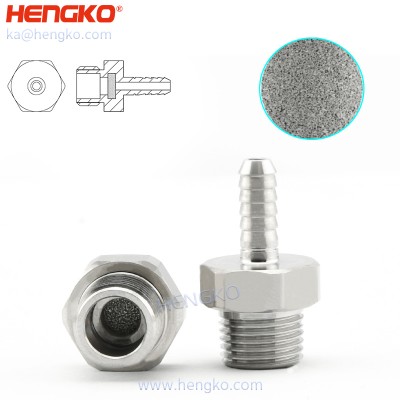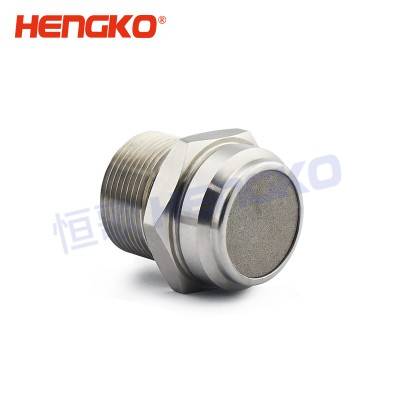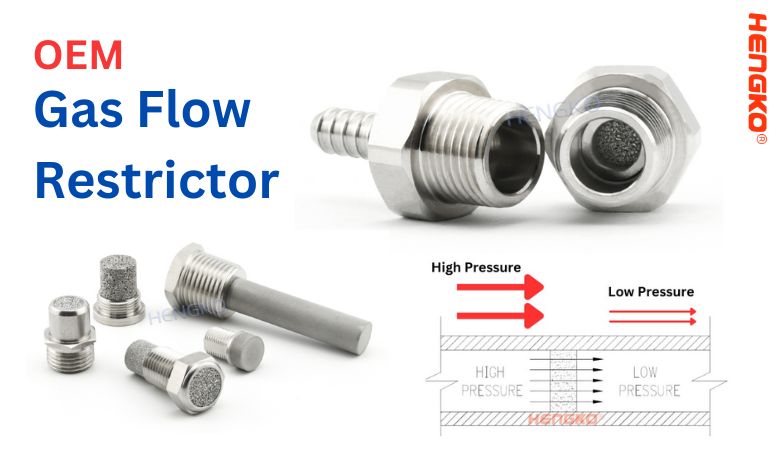-

Industrial Anti-clog Precision Porous Metal Flow Restrictors for Healthcare and Life Sc...
HENGKO manufactures filter elements in a broad range of materials, sizes, and fittings so they can be easily specified with the characteristics and configura...
View Detail -

Porous metal flow restrictors used in require anti-clogging or laminar flow applications
HENGKO delivers precision porous metal flow restrictors that provide a reliable and economical replacement for small control valves. A porous metal flow rest...
View Detail -

High Purity Flow Restrictors uesd in high-flow C-Seal configuration gas systems / flow ...
HENGKO delivers precision porous metal flow restrictors that provide a reliable and economical replacement for small control valves. A porous metal flow rest...
View Detail -

Sintered microns porosity porous metal filter air flow restrictors (laminar flow) for g...
HENGKO manufactures filter elements in a broad range of materials, sizes, and fittings so they can be easily specified with the characteristics and configura...
View Detail
What is a gas flow restrictor and how does it work?
A gas flow restrictor, also known as a flow limiter, is a device that controls the rate at which gas flows through a pipeline or system. It is typically used to maintain a constant flow rate, regardless of changes in upstream pressure or downstream demand. Gas flow restrictors are used in a wide variety of applications, including:
- Gas distribution systems: To ensure that all customers receive a consistent supply of gas, regardless of their distance from the gas source.
- Industrial processes: To control the flow of gas to furnaces, boilers, and other equipment.
- Medical devices: To control the flow of medical gases to patients.
- Laboratory equipment: To control the flow of gas to analytical instruments and other equipment.
Gas flow restrictors work by creating a pressure drop in the gas stream. This pressure drop is achieved by introducing a constriction or narrowing in the flow path. The constriction can be created in a number of ways, such as:
- Orifice plate: A thin plate with a single hole in the center.
- Porous plug: A plug with a large number of tiny holes in it.
- Venturi tube: A tube with a narrowed section in the middle.
As the gas passes through the constriction, its velocity increases and its pressure decreases. The amount of pressure drop is proportional to the flow rate of the gas. This means that the gas flow restrictor will automatically adjust the flow rate to maintain a constant pressure drop.
Gas flow restrictors are an essential component of many gas systems. They help to ensure that gas is delivered safely and efficiently to a wide variety of applications.
Types of gas flow restrictor ?
There are many different types of gas flow restrictors available, each with its own advantages and disadvantages. Some of the most common types include:
1. Orifice plate
2. Orifice plate gas flow restrictor
An orifice plate is a simple and inexpensive type of gas flow restrictor. It consists of a thin plate with a single hole in the center. The size of the hole determines the amount of flow restriction. Orifice plates are widely used in industrial gas distribution systems.
Porous plug
3. Porous plug gas flow restrictor
A porous plug is a type of gas flow restrictor that consists of a plug with a large number of tiny holes in it. The size and number of holes determine the amount of flow restriction. Porous plugs are often used in medical devices and laboratory equipment.
4. Venturi tube
5. Venturi tube gas flow restrictor
A venturi tube is a type of gas flow restrictor that consists of a tube with a narrowed section in the middle. As the gas passes through the narrowed section, its velocity increases and its pressure decreases. This creates a pressure drop across the venturi tube, which restricts the flow of gas. Venturi tubes are often used in industrial processes and laboratory equipment.
Needle valve
6. Needle valve gas flow restrictor
A needle valve is a type of gas flow restrictor that consists of a tapered needle that can be screwed in or out to adjust the flow rate. Needle valves are often used in laboratory equipment and medical devices.
7. Float valve
8. Float valve gas flow restrictor
A float valve is a type of gas flow restrictor that uses a float to control the flow of gas. As the gas level rises,
the float rises and closes the valve, restricting the flow of gas. As the gas level falls, the float falls and opens
the valve, allowing more gas to flow. Float valves are often used in fuel tanks and other storage vessels.
9. Backpressure regulator
10. Backpressure regulator gas flow restrictor
A backpressure regulator is a type of gas flow restrictor that maintains a constant pressure on the downstream
side of the regulator. This is achieved by using a spring-loaded valve to restrict the flow of gas. Backpressure
regulators are often used in industrial processes and laboratory equipment.
The type of gas flow restrictor that is best for a particular application depends on a number of factors, such as the
required flow rate, the allowable pressure drop, and the type of gas being used. It is important to consult with a
qualified engineer to select the right type of gas flow restrictor for your specific application.
Main Features of gas flow restrictor ?
* Flow control:
* Pressure regulation:
* Gas conservation:
* Flow stability:
* Safety:
In addition to these main features, gas flow restrictors can also have a number of other features, such as:
* Bidirectional flow:
* Multiple openings:
* Corrosion resistance:
* Tamper resistance:
The specific features of a gas flow restrictor will vary depending on the type of restrictor and its intended application.
It is important to select the right type of gas flow restrictor for your specific needs to ensure optimal performance and safety.
Typical applications of gas flow restrictor
Gas flow restrictors are used in a wide variety of applications, including:
* Gas distribution systems:
* Industrial processes:
* Medical devices:
* Laboratory equipment:
* Residential appliances:
Here are some specific examples of how gas flow restrictors are used in different applications:
* In a gas distribution system, a gas flow restrictor can be used to maintain a constant pressure in the pipeline, even when the demand for gas fluctuates. This is important for ensuring the safety and reliability of the gas distribution system.
* In a medical device, such as a ventilator or an anesthesia machine, a gas flow restrictor can be used to control the flow of oxygen or other medical gases to a patient. This is important for ensuring that the patient is receiving the correct amount of gas and that the gas is being delivered safely.
* In a laboratory, a gas flow restrictor can be used to control the flow of gas to a chromatography instrument or other analytical equipment. This helps to ensure that the instrument is operating properly and that the results of the analysis are accurate.
* In a residential appliance, such as a gas stove or furnace, a gas flow restrictor can be used to reduce gas consumption and save money on gas bills. However, it is important to note that using a gas flow restrictor on a residential appliance can also reduce the performance of the appliance.
Gas flow restrictors are an important part of many gas systems. They help to ensure that gas is delivered safely and efficiently to a wide variety of applications.
Can a gas flow restrictor improve the efficiency of my appliance?
Should I use a flow restrictor?
Yes, a gas flow restrictor can improve the efficiency of your appliance by limiting the amount of gas that flows through it.
This can reduce energy consumption and save you money on your gas bills.
For example, if you have an older gas furnace, it may be using more gas than necessary. A gas flow restrictor can be
installed to reduce the flow of gas to the furnace, which can improve its efficiency.
However, it is important to note that a gas flow restrictor can also reduce the performance of your appliance. For example,
if you install a gas flow restrictor on your gas stove, it may take longer to boil water or cook food.
Whether or not you should use a gas flow restrictor depends on your individual needs and preferences. If you are
looking to save money on your gas bills, then a gas flow restrictor may be a good option for you. However, if you are
concerned about the performance of your appliance, then you may want to consider other options, such as upgrading
to a newer, more efficient appliance.
Here are some of the pros and cons of using a gas flow restrictor:
| Feature | Pros | Cons |
|---|---|---|
| Reduce gas consumption | Save money on gas bills | Reduce performance of some appliances |
| Improve efficiency | Improve efficiency of some appliances | Can be expensive to install |
| Reduce wear and tear | Reduce wear and tear on appliances | May require professional installation |
If you are considering using a gas flow restrictor, it is important to consult with a qualified professional to ensure
that it is the right option for your specific needs and that it is installed correctly.
How do I install a gas flow restrictor in my appliance?
Instructions:
1. Turn off the gas supply to the appliance.
3. Apply pipe sealant to the threads of the gas flow restrictor.
4. Screw the gas flow restrictor into the gas line.
5. Tighten the gas flow restrictor with the adjustable wrench.
6. Connect the gas line back to the appliance.
7. Turn on the gas supply to the appliance.
8. Check for gas leaks using a soap and water solution.
Safety:
* Always turn off the gas supply to the appliance before installing a gas flow restrictor.
* Check for gas leaks after installing the gas flow restrictor.
If you are not comfortable installing a gas flow restrictor yourself, you should contact a qualified professional.
Additional notes:
* Some gas flow restrictors are designed to be installed in a specific direction. Be sure to follow the manufacturer's instructions for installation.
* If you are installing a gas flow restrictor on a gas stove, you may need to adjust the flame height after installation.
* If you are installing a gas flow restrictor on a gas furnace, you may need to consult with a qualified HVAC professional to ensure that the furnace is operating properly.
How do I choose the right size and type of gas flow restrictor for my needs?
To choose the right size and type of gas flow restrictor for your needs, you will need to consider the following factors:
* Required flow rate: The gas flow restrictor must be able to handle the maximum flow rate of the appliance.
Once you have considered these factors, you can select the appropriate size and type of gas flow restrictor.
Here is a brief overview of the different types of gas flow restrictors available:
* Orifice plate:
* Porous plug:
* Venturi tube:
* Needle valve:
* Float valve:
* Backpressure regulator:
If you are not sure which type of gas flow restrictor is right for your needs, you should consult with a qualified professional. They can help you select the right size and type of gas flow restrictor for your specific application.
Here are some additional tips for choosing the right gas flow restrictor:
* Select a gas flow restrictor that is made from a compatible material. Some gas flow restrictors are made from materials that are not compatible with certain types of gas. For example, brass gas flow restrictors should not be used with natural gas, as they can corrode over time.
By following these tips, you can choose the right gas flow restrictor for your needs and ensure that it is installed and maintained properly.
How often should a gas flow restrictor be replaced or serviced?
The frequency at which a gas flow restrictor needs to be replaced or serviced depends on a number of factors, including the type of restrictor, the operating environment, and the type of gas being used.
In general, gas flow restrictors should be inspected annually for signs of wear and tear, such as corrosion or erosion. If any damage is found, the restrictor should be replaced immediately.
For some types of gas flow restrictors, such as orifice plates and porous plugs, it may be necessary to clean or calibrate the restrictor on a more frequent basis. This is especially important in applications where the gas being used is dirty or corrosive.
It is important to consult with the manufacturer of the gas flow restrictor for specific recommendations on service and replacement intervals.
Here are some general guidelines for replacing or servicing gas flow restrictors:
* Orifice plates and porous plugs:
* Venturi tubes:
* Needle valves:
* Float valves:
* Backpressure regulators:
If you are not comfortable servicing a gas flow restrictor yourself, you should contact a qualified professional.
Can a gas flow restrictor cause a decrease in flame intensity in my stove?
Yes, a gas flow restrictor can cause a decrease in flame intensity in your stove. This is because a gas flow restrictor limits the amount of gas that can flow through it, which can reduce the size and intensity of the flame.
If you have noticed a decrease in flame intensity in your stove after installing a gas flow restrictor, there are a few things you can do:
* Check the size of the restrictor.
* Adjust the flame height.
* Clean the burner ports.
* Contact the manufacturer of your stove.
It is important to note that using a gas flow restrictor on a stove can also reduce the performance of the stove. For example, it may take longer to boil water or cook food. If you are concerned about the performance of your stove, you may want to consider other options for reducing gas consumption, such as upgrading to a newer, more efficient stove.
Send your message to us:









